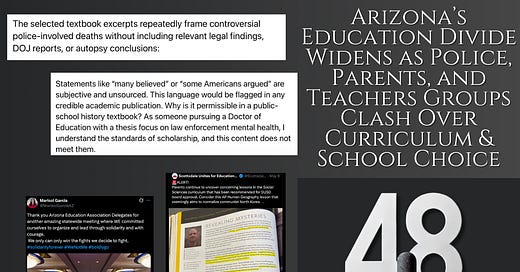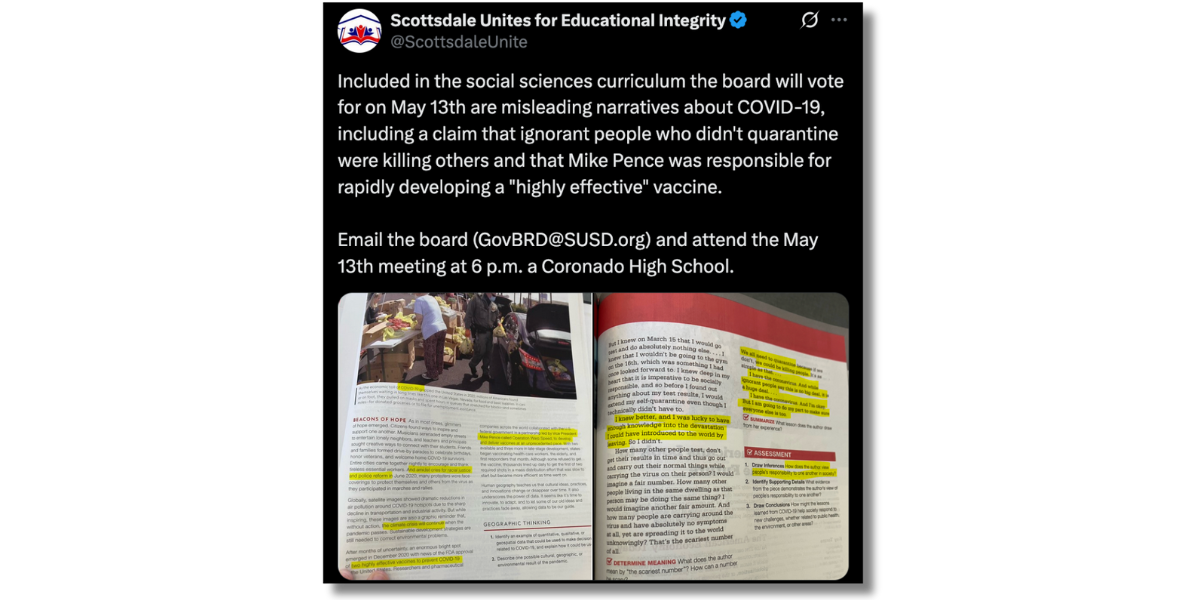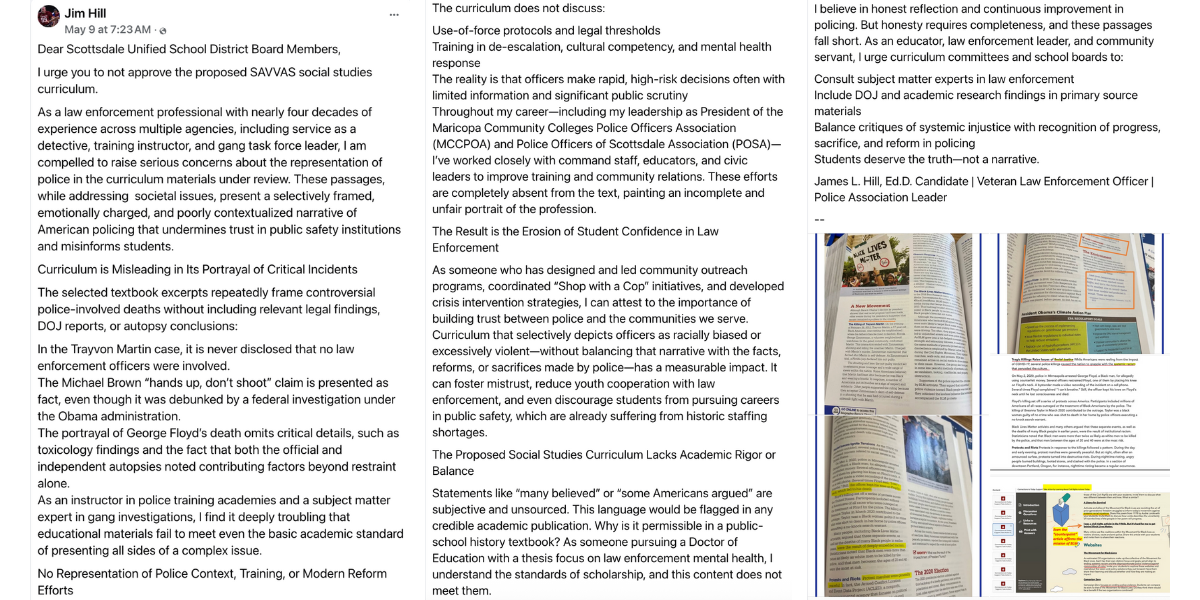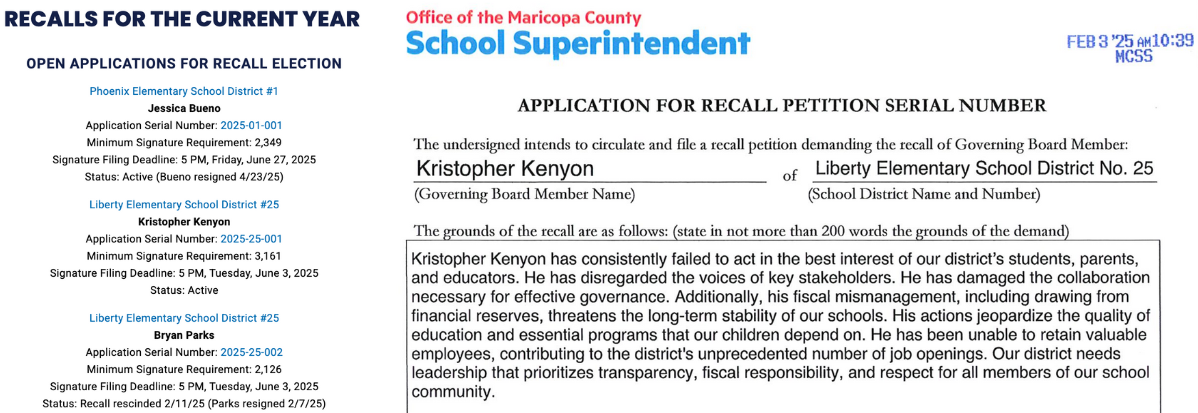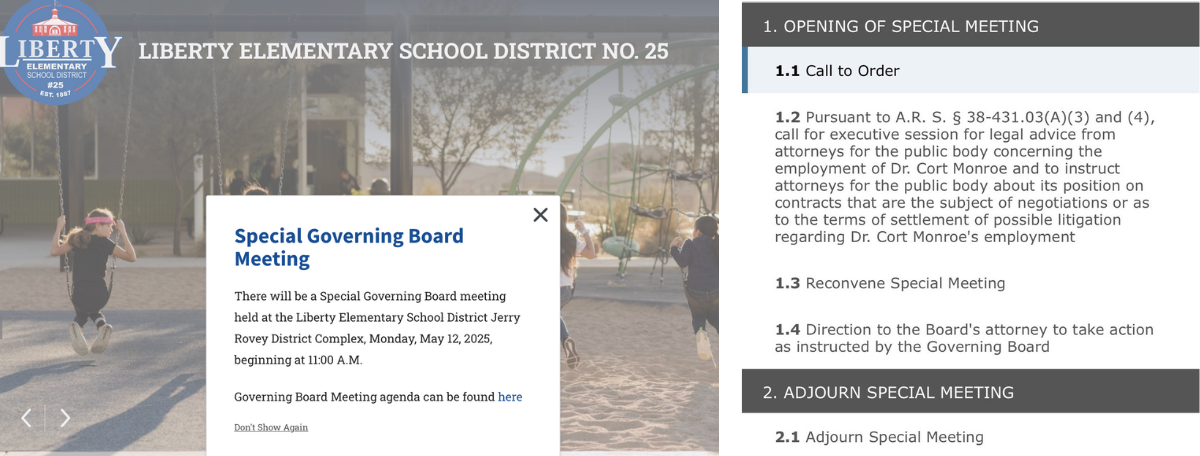Arizona’s Education Divide Widens as Police, Parents, and Teachers Groups Clash Over Curriculum & School Choice
State 48 News previews the week ahead in Arizona education, where curriculum clashes, recall efforts, and high-stakes funding debates put schools at the center of the state’s political battlefield.
Scottsdale Unified to Vote on Controversial $145K Curriculum at May 13 Board Meeting
The Scottsdale Unified School District Governing Board is set to vote Tuesday, May 13, 2025, on whether to approve a proposed $145,000 social studies curriculum sparking pushback from law enforcement leaders, board members, and community groups.
One of the chosen curriculum, published by SAVVAS Learning Company, reportedly includes content on topics such as Black Lives Matter, January 6, climate change, LGBTQ+ rights, immigration, and police brutality.
Critics say the materials promote “highly political opinions as fact.”
According to the district’s Social Sciences Curriculum Adoption Committee, vendor presentations were considered from McGraw Hill, SAVVAS, BFW, and Cengage. However, community group Scottsdale Unites for Educational Integrity claims the recommendation process was dominated by SUSD staff and lacked diverse perspectives.
Police Association President Urges Scottsdale Unified to Reject SAVVAS Curriculum
James L. Hill, MS — a veteran law enforcement officer and President of the Maricopa County Colleges Police Officers Association — is urging the Scottsdale Unified School District Governing Board to reject the proposed SAVVAS social studies curriculum, warning that it presents an “emotionally charged and poorly contextualized narrative” of American policing.
In a letter submitted May 9, Hill cites textbook excerpts on high-profile deaths — including Trayvon Martin, Michael Brown, and George Floyd — which he claims omit key legal findings, DOJ reports, and autopsy results.
“In the Trayvon Martin case, it is never disclosed that no law enforcement officers were involved,” Hill wrote. He also criticized the textbook’s portrayal of the “hands up, don’t shoot” claim and noted the exclusion of toxicology findings in the George Floyd case.
Hill argues that the curriculum fails to mention critical context such as use-of-force standards, modern reform efforts, and community policing initiatives. He warns the material could erode trust in public safety and discourage students from pursuing careers in law enforcement.
“Statements like ‘many believed’ or ‘some Americans argued’ are subjective and unsourced,” he wrote. “This language would be flagged in any credible academic publication.”
Hill, a doctoral candidate researching law enforcement mental health, called on school boards to consult subject matter experts and include DOJ research in primary materials.
“Students deserve the truth — not a narrative,” he concluded.
Scottsdale Unified Curriculum Sparks Debate: Critical Thinking Goals Clash with Concerns Over Anti-Police Rhetoric
At the April 29 SUSD Special Governing Board meeting, Board Member Amy Carney raised concerns about a section in the proposed curriculum encouraging students to “take action by learning about civil rights actions today.” Carney quoted examples from the textbook, including:
“One, social media helps Black Lives Matter fight the power. Campaign Zero, which states, ‘We can live in a world beyond policing—shrink the reliance and power of the police.’”
“Another one on there is the Movement for Black Lives: ‘Ending systemic racism and disproportionate police violence against communities of color.’”
“Invite your students to explore these websites… ‘We believe that prisons, police, and all the other institutions that put violence on Black people must be abolished. We are anti-capitalist.’”
“I could go on and on,” Carney said. “But I’m highly concerned about the negative rhetoric against police in this curriculum.”
She also pointed to public comments submitted to the district, saying, “This is exactly what parents do not want for their children and is why they are moving out of the public school.”
In response, a curriculum committee representative acknowledged the concern but noted additional materials were included to balance perspectives. She said a memo outlines how the curriculum aligns to standards and includes content designed to present “different perspectives so that students can have opportunities for critical thinking, discussion, [and] to draw conclusions.”
During the discussion, a board member clarified the intent behind the district’s approach to controversial content, asking whether the goal is not to shield students from ideas they—or members of the community—might disagree with, but rather to ensure a balanced range of viewpoints is presented.
“Am I understanding you correctly that what you're saying is: our goal isn't necessarily to avoid students being exposed to things that might be upsetting or disagreed with by any member of our community? The measure is whether there are other perspectives too,” the board member asked. “So, if you came from a politically progressive household, you might read things that upset you. If you came from a politically conservative household, the same might be true. But what you're guiding us to look at is whether, on balance, there's a diverse set of perspectives.”
A curriculum committee representative confirmed that was the guiding principle behind the "balanced perspectives" memo and overall instructional goals.
According to the district, 25 people signed into the public viewing space since its opening. 65 entries were submitted through the public feedback form, with 29 comments tied specifically to in-person visits to the public display, which was available during school hours or by appointment. A group review was also held the evening of March 17, involving community members, teachers, and Governing Board members. The committee used consensus decision-making to arrive at its final curriculum recommendation.
Over the weekend, the progressive group Save Our Schools Arizona blasted out an email titled “THIS SATURDAY! Come out for Liberty Elementary School District,” promoting a community petition drive organized by the grassroots group 4 Liberty Kids. The email encouraged the public to attend a “Power of Mom” Community Event in Goodyear, Arizona, where residents could sign a petition to recall Liberty Elementary School Board Member Kris Kenyon. Organizers welcomed parents, grandparents, students, and all concerned citizens to get involved.
But online, many pushed back on the partisan framing. Commenters noted that the issues at Liberty transcend the typical left-versus-right divide, pointing instead to growing concerns over transparency, leadership, and community trust.
However, the email claimed the Liberty ESD25 board majority was in communication with Turning Point USA, which it described as a “right-wing extremist group” led by Charlie Kirk, linking to an AZ Central article for reference. The tone and framing suggest, for SOS Arizona, this may be less about local governance and more about political gamesmanship.
The Maricopa County School Superintendent’s website currently lists three open applications for recall elections, including one for Bryan Parks, former Liberty Elementary School District Board President who resigned on February 7. Another active application targets Kristopher Kenyon, also of Liberty ESD, with petitions due by June 3rd.
The governing board will weigh cutting loose its superintendent today. The Liberty Elementary School District Governing Board holds a Special Meeting May 12th at 11am at the Jerry Rovey District Complex. The agenda includes an executive session for legal consultation regarding the employment status of Dr. Cort Monroe and potential contract negotiations or settlement terms. Any actions stemming from the closed session will take place upon reconvening in open session.
As exclusively reported: On April 21st, the Liberty Elementary School District Governing Board voted 4–1 to place Superintendent Dr. Cort Monroe on paid administrative leave, appointing Dr. Stephanie Mohorne as acting superintendent. A State 48 News review of current LESD job postings found 94 vacancies, (today it’s 93), across all eight schools and the district office—including 33 certified elementary teachers and 14 middle school teachers—highlighting a growing staffing crisis.
Over the weekend, Arizona Education Association (AEA) President Marisol Garcia posted to X, thanking delegates for what she described as an “amazing statewide meeting” where educators committed to organizing and leading “through solidarity and with courage.”
“We only can win the fights we decide to fight,” Garcia wrote.
The Arizona Education Association, Save Our Schools Arizona, and Democratic lawmakers are signaling strong opposition to any version of Proposition 123 which ties teacher pay raises to legal protections for Arizona’s school choice programs—including ESAs and school choice.
In an email sent Sunday morning, Save Our Schools Arizona criticized Republican efforts to advance the measure, calling the process chaotic and politically motivated.
“On again, off again,” the group wrote, noting the measure was originally expected to be heard on May 7—just one day after education groups and Democrats held a joint press conference opposing it. The vote was then pushed to May 8, with a planned GOP press conference alongside Goldwater Institute-backed ‘Love Your School’—which was also abruptly postponed.
SOSAZ said the House then adjourned until May 20 and the Senate until May 28, delaying the vote again amid what they describe as “swirling rumors that multiple Republican lawmakers are unhappy with the proposal.”
“Faced with unanimous Democratic opposition, Republicans can't lose many votes if they expect the measure to pass,” the email stated.
AEA and SOSAZ are expected to escalate opposition if the final version includes provisions shielding school choice policies.
State 48 News Senior Investigative Journalist Jennifer Barber has been at the forefront of reporting on the Liberty Elementary School District, where board members have embraced conservative principles—scrapping Common Core math, implementing new discipline policies, and facing growing community pushback. You can find her full coverage and video reports on her YouTube channel.


